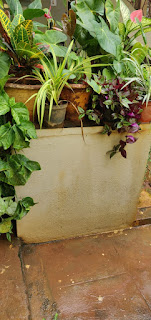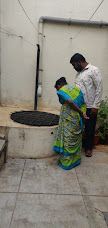On 11th visit to Vidyaranyapura, I witnessed interesting stories on wells. I am sharing few stories here:
1. The significance of open wells
" The question on water supply to households by the government came only in 1987 when the housing society started to supply the water to households. Before 1987, households had to find a source of water themselves. Back then the lakes were full and every household dug open wells. There was no thought on drilling borewells. Open wells played a significant role before the formal supply of piped water by the government. After piped water, there was no need to use open wells as there was sufficient water supply. People ignored open wells. That was also the time of borewell intrusion. The borewells have led to the collapse in groundwater table. Majority of the households closed their wells as they ran dry".
- Mr. Raja Mani is the resident of 2nd block, Vidyaranyapura
2. Community connect with the wells
People had a strong connection with their wells irrespective of they using the well or otherwise. Though it was bit difficult to start a conversation but it would go smooth once they start to share their stories. I have seen 20 wells and spoken to 10-12 people. There were hardly two to three people who were not open to have a conversation on their well. Majority of the welcomed the conversation on well and water and few people very enthusiastic to share their views and stories. It was very great to see people coming forward to talk about their wells.
3. Re-digging of open wells
Every time I am on field, I would notice a sense of regret from the people for closing their wells. They would decide to close their wells for reasons like space constraint, sewage contamination, vastu, sufficient piped water supply etc. They may not have always taken the decision out of their choice. When they are initiated with the conversation on well, they would take a pause and think if closing the well was a right idea or would they have done something better. In a nut shell most of the people in Vidyaranyapura residents are connected to their wells emotionally.
1. Mr.Raja Mani had dug an open well in 1983, he was using the well till 1987. After getting piped water he closed the well from top. Later during 2015, while renovating and rebuilding the house, he closed the well with debris. While applying for building approval, the form mentioned rainwater harvesting is mandatory for the approval. He then removed the debris and re-dug the well for 7ft.
2. Mr.Kamesh Mahadevan had an old open well which was more than 20 years old. He had closed the well in 2019 as it was not in a right location according to vastu. He was inspired by Mr.Vishwanath's post and wanted to dig an open well again. He was interested to use the well water. He got in touch with Biome and dug an open well in 2019. He has allowed the rooftop rainwater to recharge the well. The well is 4ft in diameter and 20ft deep. The well hit water at 7ft and as of now the well is not holding water and working as a recharge well. He is planning to re-deepen the well to 30ft as neighbor wells of 30ft deep has water. He expects the well will start to hold water in the coming year.
 Mr.Kamesh's well
Mr.Kamesh's well
4. Groundwater recharge
The residential households in Vidyaranyapura have taken up the initiatives of groundwater recharge.
There are residents who are just using their open wells to recharge the rooftop rainwater(not using the well water) to comply with building bylaws. Households who use the open well water extensively have directed the rooftop water into the well to improve the water level and also the water quality. Households have dug recharge wells as a conscious step towards sustainable water management.
1. Mr. Sathish is the resident of Chamundi layout, Vidyaranyapura. He dug the recharge well to fulfill the building bylaws which mandate RWH and he was also interested in sustainable water management in his house. The recharge well was dug by Plumber Mohan. It is 4ft wide and 20ft deep. The well did not hit water and Mr.Sathish is interested to re-deepen the well to 30ft like Mr.Kamesh as the neighbor wells which hold water are 30ft deep.
5. Use of open well water for construction:
Mr.Raghuram built his house during 2017. He chose to dig an open well over borewell to build the house. The well was dug by Well digger Shankar(Ph:9900283755) and team and it went up to 18ft deep and 3ft in diameter. He hit water at 8ft and got 5 inches of water. The entire house was built using this water and no additional sources of water(water tankers) were used. Currently the well has water at 5ft from the ground level. The well water is used for all domestic purposes. In addition, he has let rooftop rainwater into the sump tank(9000litre) and channelized the overflow towards the open well.
Mr.Rajamani's well mentioned above was used to build a neighbor's house during 2015-16. The entire G+2 house was built using the open well water.

Raghuram's open well












